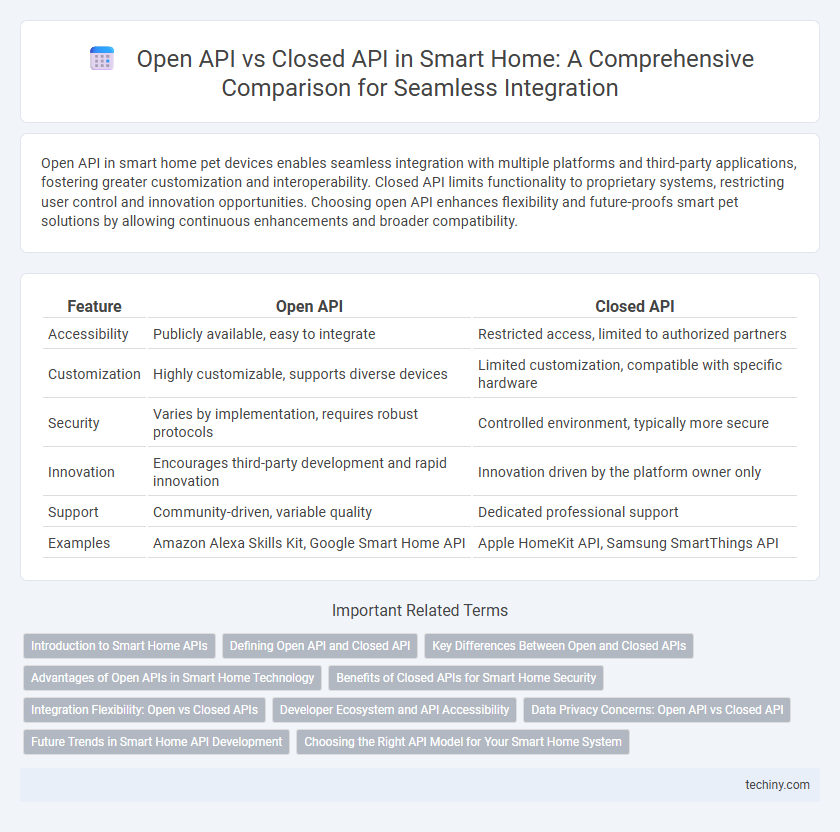Open API in smart home pet devices enables seamless integration with multiple platforms and third-party applications, fostering greater customization and interoperability. Closed API limits functionality to proprietary systems, restricting user control and innovation opportunities. Choosing open API enhances flexibility and future-proofs smart pet solutions by allowing continuous enhancements and broader compatibility.
Table of Comparison
| Feature | Open API | Closed API |
|---|---|---|
| Accessibility | Publicly available, easy to integrate | Restricted access, limited to authorized partners |
| Customization | Highly customizable, supports diverse devices | Limited customization, compatible with specific hardware |
| Security | Varies by implementation, requires robust protocols | Controlled environment, typically more secure |
| Innovation | Encourages third-party development and rapid innovation | Innovation driven by the platform owner only |
| Support | Community-driven, variable quality | Dedicated professional support |
| Examples | Amazon Alexa Skills Kit, Google Smart Home API | Apple HomeKit API, Samsung SmartThings API |
Introduction to Smart Home APIs
Smart Home APIs enable seamless integration between devices and platforms, allowing users to control lighting, security, and appliances through a unified interface. Open APIs offer greater flexibility and community-driven innovation by providing accessible programming interfaces for developers to build custom applications. Closed APIs, while restricting third-party access, ensure tighter security and consistent performance by limiting interactions to authorized partners and proprietary systems.
Defining Open API and Closed API
Open API in smart home systems refers to publicly available interfaces that allow developers to access and integrate device functionalities, promoting interoperability and customization across various platforms. Closed API, on the other hand, restricts access to the system's internal functions, limiting integration to approved applications and maintaining tighter control over security and user experience. Choosing between open and closed APIs affects device compatibility, development flexibility, and ecosystem scalability within smart home environments.
Key Differences Between Open and Closed APIs
Open APIs in smart home systems enable developers to access and integrate features freely, fostering innovation and compatibility across multiple devices and platforms. Closed APIs restrict access, limiting integrations to authorized partners, which enhances security but reduces flexibility and third-party collaboration. The key differences lie in accessibility, control, and the potential for ecosystem expansion within smart home technology.
Advantages of Open APIs in Smart Home Technology
Open APIs in smart home technology enable seamless integration across diverse devices, fostering interoperability and enhancing user convenience. They support faster innovation by allowing developers to create customizable solutions tailored to specific user needs. Enhanced security frameworks within open APIs also promote safer data exchange compared to proprietary closed systems.
Benefits of Closed APIs for Smart Home Security
Closed APIs in smart home security offer enhanced protection by limiting access to authorized developers, reducing vulnerabilities from external threats. They ensure tighter control over device interactions, minimizing risks of data breaches and unauthorized manipulations. This controlled environment supports consistent security updates and reliable performance across connected smart home systems.
Integration Flexibility: Open vs Closed APIs
Open APIs in smart home systems offer exceptional integration flexibility, enabling seamless connectivity with a wide range of third-party devices and platforms through standardized protocols and well-documented interfaces. Closed APIs, by contrast, limit integration possibilities to a predefined ecosystem, restricting interoperability and customization to proprietary devices and services. This distinction significantly impacts the scalability and adaptability of smart home solutions, with Open APIs facilitating broader innovation and user control.
Developer Ecosystem and API Accessibility
Open API in smart home systems fosters a robust developer ecosystem by enabling widespread access to integrations, promoting innovation through shared documentation and community support. Closed API limits accessibility, restricting developers to proprietary tools and slowing collaborative growth within the smart home market. API accessibility directly impacts the speed and diversity of connected devices and applications, influencing overall platform adoption and user experience.
Data Privacy Concerns: Open API vs Closed API
Open APIs in smart home systems enable extensive third-party integrations but raise significant data privacy concerns due to broader access permissions and potential exposure to unauthorized data sharing. Closed APIs restrict access to proprietary ecosystems, offering enhanced control over user data and minimizing risks associated with data breaches or misuse. Choosing between open and closed APIs involves balancing interoperability with stringent data privacy requirements essential for safeguarding smart home user information.
Future Trends in Smart Home API Development
Open APIs in smart home development enable seamless integration across diverse devices and platforms, fostering innovation and expanding ecosystem compatibility. Closed APIs, while offering enhanced security and controlled environments, may limit interoperability and slow adoption of emerging technologies like AI-driven automation and edge computing. Future trends indicate a shift towards hybrid API models combining openness for developer flexibility with stringent security protocols to meet the growing demand for scalable, secure, and intelligent smart home solutions.
Choosing the Right API Model for Your Smart Home System
Choosing the right API model for your smart home system depends on openness and integration flexibility; Open APIs allow seamless connectivity with multiple devices and third-party services, enhancing automation and user control. Closed APIs restrict access to proprietary ecosystems, offering better security but limiting compatibility and expansion options. Evaluating your priorities regarding interoperability, security, and future scalability helps determine whether an Open API or Closed API best suits your smart home architecture.
Open API vs Closed API Infographic

 techiny.com
techiny.com